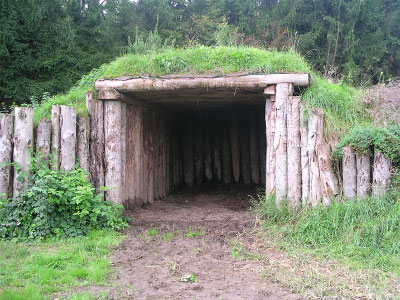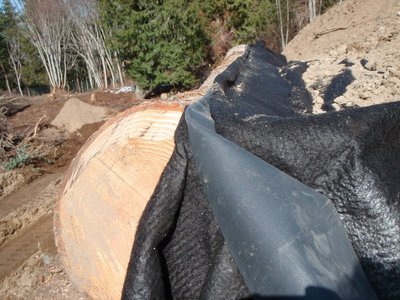
Underground animal shelter
 Before
we can cut up the big,
straight trees from the pasture clearing expedition, we need to
decide whether we want to use them for creating an animal house.
Mark has suggested making a Holzer-like, semi-underground
dwelling for this area and I'm intrigued by the idea.
Before
we can cut up the big,
straight trees from the pasture clearing expedition, we need to
decide whether we want to use them for creating an animal house.
Mark has suggested making a Holzer-like, semi-underground
dwelling for this area and I'm intrigued by the idea.
Holzer creates
open-fronted shelters using logs as the walls and roof, puts on a pond
liner sandwiched between two layers of building felt, then piles dirt
on top. Heavy equipment means he can create a shelter like this
in a day, but it seems feasible to do it by hand over a longer time
period with three workers. I estimate the total cost would be
about $300 for the pond liner and maybe another $30 or $40 for the
building felt for a 6-or-7-foot-square structure.
 The question is --- would it
be a lot more work than an aboveground shelter? Would soft
tulip-trees stand up for at least a decade or two in the ground if the
liner extends out on all sides for a couple of feet and we try to
channel the water away from the structure? (Holzer apparently
uses tamarack, which as best I can tell is naturally rot-resistant, a
bit like cedar.) Would it be better to make the building
log-cabin-style with the few red cedars we have as the bottom layer to
lower the rot potential? At the other extreme, is it worth saving
a couple of hundred dollars by using cheaper plastic (as Mike Oehler
does in his underground houses), perhaps with a pond liner for the roof
only? And, since this structure would probably also be home to
chickens, would birds enjoy a cave-like dwelling as much as pigs and
cows apparently do?
The question is --- would it
be a lot more work than an aboveground shelter? Would soft
tulip-trees stand up for at least a decade or two in the ground if the
liner extends out on all sides for a couple of feet and we try to
channel the water away from the structure? (Holzer apparently
uses tamarack, which as best I can tell is naturally rot-resistant, a
bit like cedar.) Would it be better to make the building
log-cabin-style with the few red cedars we have as the bottom layer to
lower the rot potential? At the other extreme, is it worth saving
a couple of hundred dollars by using cheaper plastic (as Mike Oehler
does in his underground houses), perhaps with a pond liner for the roof
only? And, since this structure would probably also be home to
chickens, would birds enjoy a cave-like dwelling as much as pigs and
cows apparently do?
I'd be very curious to
hear from anyone who has tried to make a Holzer-like underground animal
shelter on the backyard scale. What worked and didn't work for
you?
Want more in-depth information? Browse through our books.
Or explore more posts by date or by subject.
About us: Anna Hess and Mark Hamilton spent over a decade living self-sufficiently in the mountains of Virginia before moving north to start over from scratch in the foothills of Ohio. They've experimented with permaculture, no-till gardening, trailersteading, home-based microbusinesses and much more, writing about their adventures in both blogs and books.
Want to be notified when new comments are posted on this page? Click on the RSS button after you add a comment to subscribe to the comment feed, or simply check the box beside "email replies to me" while writing your comment.

Look up Glenn Kangiser for an unbelievable underground home using Mike Oehler's methods. Glenn is very accessible to answer questions, he is on countryplans a lot.
http://glennkathystroglodytecabin.blogspot.com/
I talked this over with my husband, who is a geotechnical engineer and does this kind of thing for a living. He says there is nothing inherently wrong with the structure, but the main issue is always going to be drainage. The more moisture is in contact with the wood, the faster it will rot. Earth, by its very nature, exudes moisture, which is why it is necessary to have a barrier between the wood and the dirt. (I was very depressed when I found out that hobbit holes couldn't be built exactly like Tolkien described them.)
A pond liner sandwiched between building felt is not a bad way to build such a barrier. However, there are purpose-designed geotech fabrics that are a bit better (they are already sandwiched, for one). My husband suggests trying to find a local supplier of what is called geocomposite sheet drain or drainage geocomposite, which would work really well for this kind of structure. He's not sure if the amounts you're going to need will be competitive on price compared to the pond liner/building felt idea -- in his business, he works with enormous rolls that come out to really cheap per square foot, but you wouldn't be buying an enormous roll, so it might be more expensive to buy smaller quantities. But if you can't get or don't want those fabrics, the pond liner/building felt combination should work well. Also, you don't actually need the building felt layer next to the wood, you only need it next to the dirt, if you want to save a little bit more.
For drainage, you should dig a trench along the outside of the wood structure, where you will eventually put the dirt. For a commercial building, you would then put a perforated pipe in this trench, but for your building, you can extend the building felt across the ditch, fill the ditch up with something porous like gravel, and then wrap the building felt back up over the gravel. This will prevent the dirt from filling the trench in. Then, you can pile the dirt over the walls, and when the moisture from the earth hits the plastic barrier, it will roll off, down, into the trench, and out the front. The whole building should be slightly tilted towards the front (inside and outside), so water will flow out the front.
Soil type is also an issue. If the soil is predominately clay, drainage will be more of a problem. If the soil is predominately sand, it will be less of a problem. If the soil is very clayey, you might end up with too much humidity inside the structure no matter what you do.
You will also dramatically increase the life span of the structure if the wood is well-seasoned before it's used to build the walls, so the trees should dry for a year or two (so no using ones you just cut down this season). And I am supposed to remind you that without heavy equipment (or a horse), it's going to take even three people a fair amount of time. That's a lot of soil to move by hand.
Here are some links for manufacturers of geocomposite sheet drains. They aren't suppliers, you can't order directly from them, but they should give you an idea of what you would be looking for: http://www.americanwick.com/products/product_cat_detail.cfm?prod_cat_id=26 http://www.nilex.com/products/drainage/sheet_drains http://acfwest.com/sheet-drain http://buildingmaterials.cetco.com/LeftSideNavigation/PRODUCTS/DrainageSolutions/AquadrainsupregsupSheetDrainage/tabid/1590/Default.aspx http://www.geo-synthetics.com/geocomposite_soil_sheet.html
And if you want, these specialty filters would work a bit better than building felt: http://www.usfabricsinc.com/products/nonwoven http://www.skaps.com/index.php?option=com_content&view=section&id=22&Itemid=155 http://www.nilex.com/products/geotextiles/nonwoven_geotextiles http://www.tencate.com/amer/geosynthetics/products/geotextiles/TenCate-Mirafi-N-Series/default.aspx
Methods that doesn't use wood are the nubian vault using Compressed Earth Blocks, since you seem to have a clay soil. According to the latter link:
Note how these technologies use mostly local materials.
A big howdy to you folks at The Walden Effect!
I gotta say, I really like what you've done with your informational website.
I see you've been able to use Paul Wheaton's image from richsoil.com. We're totally cool with that! Provided you also link to him as the source of your image. Think you could copy/paste the following link below the image, so everybody wins?
{ https://richsoil.com/sepp-holzer/sepp-holzer-permaculture.jsp }
Thanks so much, reach out if you have any questions!
Sunflower